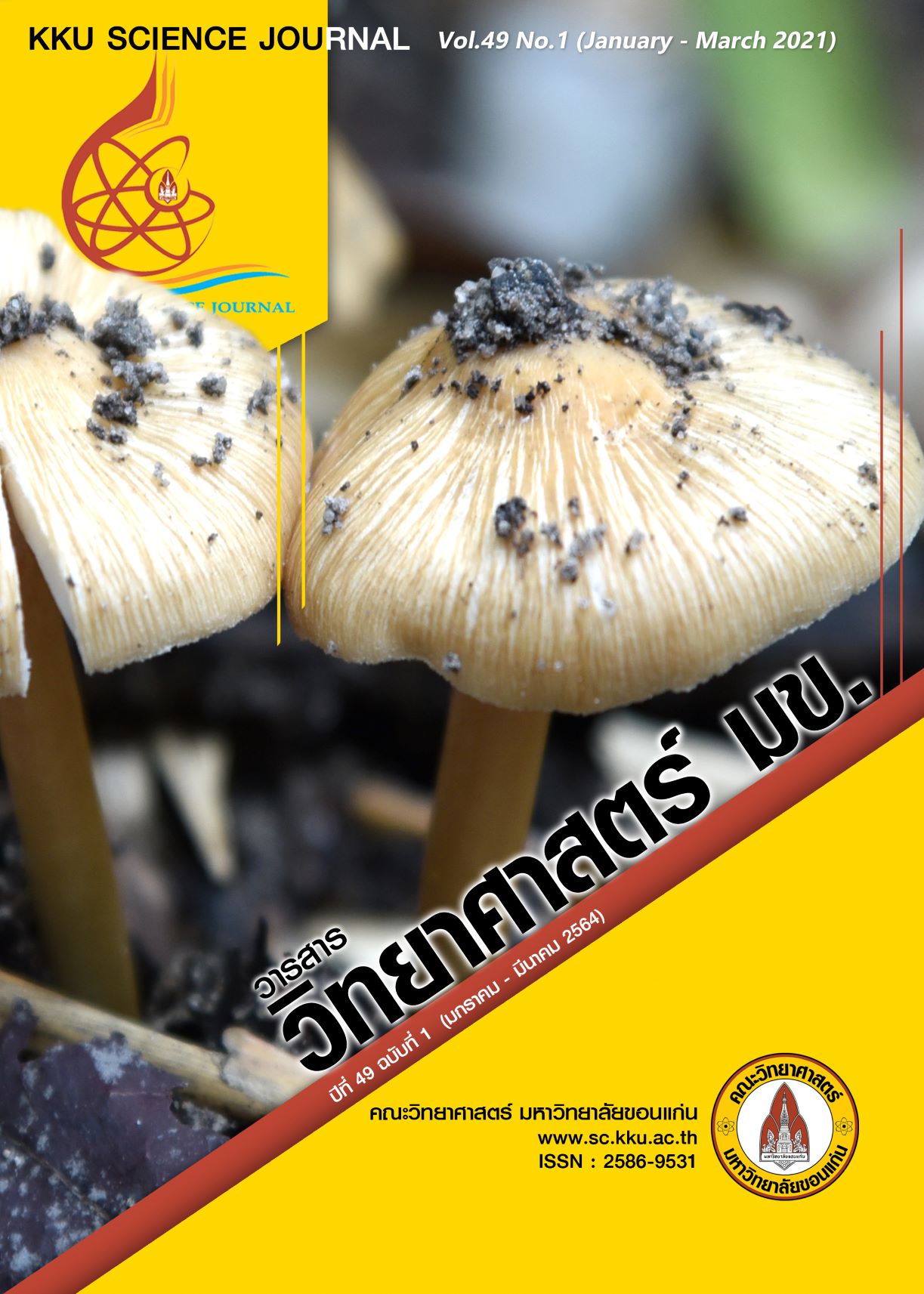Isolation and Selection of Copper Bioleaching Bacteria and Optimization using Response Surface Methodology on Copper Recovery from Discarded Printed Circuit Boards
Main Article Content
Abstract
Discarded printed circuit board (PCB) is classified as an electronic waste containing high amounts of heavy metals. These elements pose a threat to human health and the environment. However, at the same time, such metals can generate high return income. This study uses biological leaching technology to leach the copper out of the printed circuit board. The bacteria with copper leachate ability were isolated and selected from soil and sediment samples. The bacterium isolate FM-3 was found to have this ability. Based on the use of 16S rRNA gene sequencing, it was found that the bacterium was classified as Pseudomonas stutzeri strain FM-3. The optimum conditions were determined using the Response Surface Methodology (RSM) and the Box-Behnken Design experiment set was used to investigate the effects of three factors, including the pulp density, bacterial cell density and temperature. It was found that these three factors influence the optimum conditions for leaching of copper from printed circuit boards. The data of the experimental set were appropriate for predicting the optimum conditions for copper leaching because it gives a high coefficient of determination (R2 = 0.988).
Article Details

This work is licensed under a Creative Commons Attribution-NonCommercial-NoDerivatives 4.0 International License.
References
กรมควบคุมมลพิษ. (2550). ยุทธศาสตร์การจัดการซากผลิตภัณฑ์เครื่องใช้ไฟฟ้าและขยะอิเล็กทรอนิกส์เชิงบูรณาการ. สํานักจัดการกากของเสียและสารอันตรายกระทรวงทรัพยากรธรรมชาติและสิ่งแวดล้อม. หน้า 23-28.
ฉวีวรรณ จันทร์เณร และศรากร อักษรแก้ว. (2560). การประยุกต์ใช้เทคโนโลยีการผลิตโลหะเป้าหมายจากแร่ที่อยู่ภายใต้การกํากับดูแลของกรมอุตสาหกรรมพื้นฐานและการเหมืองแร่เพื่อเป็นแนวทางในการรีไซเคิลโลหะจากของเสียที่มีศักยภาพ. กรมอุตสาหกรรมพื้นฐานและการเหมืองแร่. หน้า 24-25.
ฉัดรฤดี ศิริลําดวน และอาณัติ ดีพัฒา. (2560). การนําทองแดงกลับมาใช้ใหม่จากสารละลายสังเคราะห์ของสารประกอบเชิงซ้อนทองแดงกับกรดอิ นทรีย์ที่ได้จากการสกัดขยะอิเล็กทรอนิกส์ด้วยการสกัดทางชีวภาพด้วยเรซิน. วารสารวิจัยสาธารณสุขศาสตร์มหาวิทยาลัยขอนแก่น 10(3): 76–90.
ชมพูนุท พรหมภักดิ์. (2554). แนวทางการรับมือปัญหาขยะอิเล็กทรอนิกส์ในประเทศไทย ( The ways to cope with the problem of electronic waste in Thailand) . สำนักวิชาการสำนักงานเลขาธิการวุฒิสภา 2(9): 11–15
นภาพร อรุณเกียรติก้อง และปราโมทย์ ภูพานทอง. (2551). บทที่ 2 เศษทิ้งหรือของเสียอิเล็กทรอนิกส์ (Electronics wastes). ต้นแบบกาแยกสกัดโลหะทองแดงจากแผ่นวงจรอิเล็กทรอนิกส์: กรมอุตสาหกรรมพื้นฐานและการเหมืองแร่. หน้า 2-8.
อรวรรณ พู่พิสุทธิ์ และศุลี พรแสงกระจ่าง. (2553). ความเป็นพิษของขยะอิเล็กทรอนิกส์. วารสารพิษวิทยาไทย 25(1): 67–76.
Arshadi, M., Mousavi, S. M. and Rasoulnia, P. (2016). Enhancement of simultaneous gold and copper recovery from discarded mobile phone PCBs using Bacillus megaterium: RSM based optimization of effective factors and evaluation of their interactions. Waste Management 57: 158–167.
Cárdenas, J. P. , Quatrini, R. , and Holmes, D. ( 2016) . Genomic and metagenomic challenges and opportunities for bioleaching: a mini- review. Research in Microbiology 167(7): 529–538.
Das, N. (2010). Recovery of precious metals through biosorption - A review. Hydrometallurgy 103(1–4): 180–189.
Frank, J. A., Reich, C. I., Sharma, S., Weisbaum, J. S., Wilson, B. A. and Olsen, G. ( 2008) . Critical evaluation of two primers commonly used for amplification of bacterial 16S rRNA genes. Applied and Environmental Microbiology 74( 8) : 2461–2470.
Ghosh, B., Ghosh, M. K., Parhi, P., Mukherjee, P. S., and Mishra, B. K. ( 2015) . Waste printed circuit boards recycling: an extensive assessment of current status. Journal of Cleaner Production 94: 5–19.
Hubau, A. , Minier, M. , Chagnes, A. , Joulian, C. , Perez, C. and Guezennec, A. G. ( 2018) . Continuous production of a biogenic ferric iron lixiviant for the bioleaching of printed circuit boards (PCBs). Hydrometallurgy 180: 180–191.
Iqbal, A. , Ahsan, K. , Afzal, S. , Shang, Z- H. , Sajjad, W. , Rehmen, M. , Usman, K. and Usman, M. ( 2018) . Evaluation of copper extraction potential of Pseudomonas aeruginosa from low- grade copper ore. International Journal of Biosciences 13(6): 115–121.
Işıldar, A., Hullebuscha, E. D., Lenz, M., Laing, G. D., Marra, A., Cesaro, A., Panda, S., Akcil, A., Kucuker, M. A. and Kuchta, K. (2019). Biotechnological strategies for the recovery of valuable and critical raw materials from waste electrical and electronic equipment ( WEEE) – a review. Journal of Hazardous Materials 362: 467–481.
Işıldara, A., Vossenberg, J., Rene, E. R., Hullebusch, E. D. and Len, P. ( 2016) . Two- step bioleaching of copper and gold from discarded printed circuit boards ( PCB) . Waste Management 57: 149–157.
Kumar, A. (2018). Bioleaching of metals (Cu, Au and Ag) from waste computer printed circuit boards using cyanogenic microorganisms. doctor of philosophy. Department of Biotechnology and Bioinformatics, Jaypee University of Information Technology, India. 128 pp.
Liu, R. , Li, J. and Ge, Z. ( 2016) . Review on Chromobacterium violaceum for gold bioleaching from e- waste. Procedia Environmental Sciences 31: 947–953.
Saiden, M. and Tarawneh, A. (2015). Estimation of potential E-waste generation in Jordan. Ekoloji 24(97): 60–64.
Shabani, M. A. , Irannajad, M. , Azadmehr, A. R. and Meshkini, M. (2013). Bioleaching of copper oxide ore by Pseudomonas aeruginosa. International Journal of Minerals, Metallurgy and Materials 20(12): 1130–1133.
Shang, J. Q. and Liu, P. ( 2013) . Soil cementation generated and enhanced by electrokinetics. In geotechnical special publication. In: University of Science and Technology of China. October 2013. 205–212.
Silva, R. A., Park, J., Lee, E., Park, J., Choi, S. Q. and Kim, H. (2015). Influence of bacterial adhesion on copper extraction from printed circuit boards. Separation and Purification Technology 143: 169–176.
Stackebrandt, E. and Goebel, B. M. (1994). Taxonomic note: a place for DNA- DNA reassociation and 16s rRNA sequence analysis in the present species definition in bacteriology. International Journal of Systematic Bacteriology 44( 4) : 846–849.
Tsydenova, O. and Bengtsson, M. ( 2011) . Chemical hazards associated with treatment of waste electrical and electronic equipment. Waste Management 31(1): 45–58.
Wang, G-W., Chen, T-H., Yue, Z-B., and Wang, J. (2013). Isolation and characterization of Pseudomonas stutzeri capable of reducing Fe (III) and nitrate from skarn-type copper mine tailings. Geomicrobiology 10: 16–19.
Zachariah, P. and Liston, J. ( 1973) . Temperature adaptability of psychrotrophic Pseudomonas. Applied Microbiology 26(3): 437–438.
Zhang, L. and Xu, Z. (2016). A review of current progress of recycling technologies for metals from waste electrical and electronic equipment. Journal of Cleaner Production 127: 19–36.


